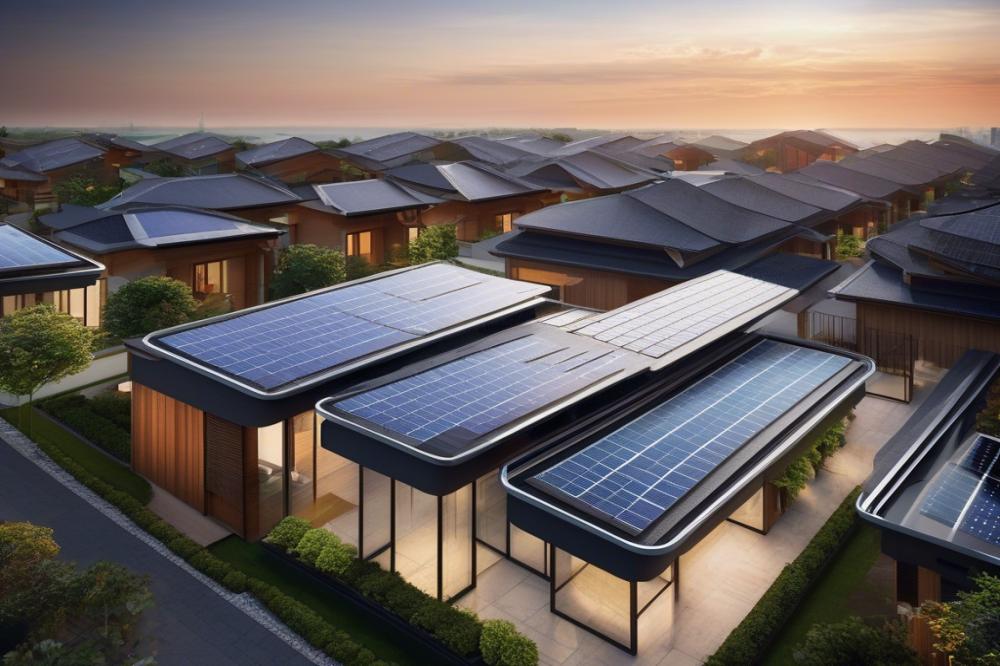Introduction
solar roof tiles represent a significant advancement in renewable energy technology. These tiles not only serve as a protective layer for homes but also harness solar energy. This dual function speaks to their importance in today’s world, where environmental concerns dominate discussions about energy usage.
At the heart of modern architecture lies the quest for sustainability and energy efficiency. Traditional building materials often fall short in meeting the demands of an eco-friendly future. Transitioning to clean technology, such as photovoltaic tiles, plays a crucial role in promoting green building practices. Homeowners increasingly seek ways to minimize their carbon footprint while still enjoying aesthetic appeal.
Innovative design is vital in developing solutions that blend aesthetics with function. The idea of building-integrated photovoltaics takes this concept a step further. It allows for the integration of solar power generation directly into the fabric of buildings. This offers an opportunity for energy independence and can transform typical structures into energy-producing assets.
Across the globe, solar projects reflect a growing trend toward adopting cleaner, more sustainable building solutions. With a focus on energy conservation, these initiatives spotlight the power of design in achieving ecological goals. From residential complexes to commercial spaces, the impact of such advancements cannot be overstated.
As we explore top solar roof tile projects worldwide, it becomes evident that a new era in construction is dawning. Each initiative showcases the promise of renewable energy in blending with culture and lifestyle. These developments are not just about panels on roofs; they symbolize a shift toward a greener future.
The Rise of solar roof tiles

Solar roof tiles represent a modern approach to renewable energy. These tiles integrate directly into a building’s structure. Made from materials that can capture sunlight, they convert it into electricity. Known as building-integrated photovoltaics, they combine functionality with aesthetics.
When compared to traditional solar panels, these tiles offer a different advantage. Regular panels are often bulky and mounted on rooftops. In contrast, the tiles blend seamlessly into the roof design. This innovative design allows homeowners to maintain their building’s visual appeal while generating clean technology. Features like sleekness and functionality lead to greater energy efficiency.
Environmental benefits of these tiles are considerable. First, they promote sustainable architecture by reducing reliance on fossil fuels. By generating energy on-site, homeowners can achieve greater energy independence. This trend aligns with global aims to enhance green building practices. Furthermore, solar projects using these tiles can significantly reduce carbon footprints. Embracing this technology supports a healthier planet while meeting energy needs.
Adopting photovoltaic tiles can also lower energy costs over time. Although initial investments can be higher, savings accumulate as energy bills decrease. Homeowners often appreciate the long-term financial benefits. The dual purpose of providing power and protection makes them an attractive choice.
Communities around the globe are beginning to prioritize such technologies. Awareness of climate change and resource scarcity drives this trend. Many regions now promote incentives for clean energy solutions. Innovative designs like solar roof tiles pave the way for a future where sustainability is key.
Notable Solar Roof Tile Projects

Case Study 1: Tesla Solar Roof
Tesla’s innovative design has transformed the way many view energy generation. The company launched a solar roof that incorporates photovoltaic tiles seamlessly into a building’s architecture. Homeowners now have the chance to generate their own renewable energy while enhancing their property’s appeal. This integration helps promote sustainable architecture and challenges the traditional roofing industry.
Many who choose Tesla’s offering are driven by the desire for energy independence. By harnessing the sun’s power, they can significantly reduce or even eliminate their electricity bills. Consequently, the clean technology movement gains momentum, encouraging more families to explore similar energy solutions.
Case Study 2: BIPV Projects in Europe
Across Europe, numerous successful building-integrated photovoltaics projects are making waves. Cities are embracing energy efficiency and sustainable urban development strategies. Unique initiatives combine aesthetic appeal with environmental responsibility, creating vibrant communities.
Architects and city planners are collaborating to install solar capabilities into new buildings. This approach offers incredible benefits, as the structures not only generate energy but also promote greener lifestyles. Overall, the impact on urban areas is profound, with a noticeable shift towards clean technology integration.
Case Study 3: International Solar Roof Project in Asia
A significant solar roof installation in Asia stands out as a prime example of renewable energy adoption. This ambitious project highlights how technology can improve energy infrastructure on a large scale. Communities participating in this initiative are experiencing tangible benefits, including lower energy costs and enhanced environmental awareness.
Additionally, the project’s success encourages similar solar projects throughout the region. People now understand the value of embracing clean technology for their homes and businesses. The initiative fosters a sense of local pride and inspires others to invest in green building methods.
Challenges and Future of Solar Roof Tiles
Current challenges are significant for the market. High costs remain a major barrier. Many homeowners hesitate to invest in these innovative design solutions. Installation can also be complex and time-consuming. Experience is necessary to achieve the best results. Therefore, finding skilled workers for solar projects is crucial.
Perception is another hurdle to overcome. Some view photovoltaic tiles as trendy but impractical. Others worry they will not be as effective as traditional solar panels. These misunderstandings can limit adoption. In contrast, many architects and builders advocate for sustainable architecture. They emphasize the benefits of integrating clean technology into new designs.
Future trends might reshape how society views roof tiles. Advances in battery storage could enhance energy independence. New materials can make tiles more durable and efficient. Researchers are exploring improved building-integrated photovoltaics that blend into structures seamlessly. Cleaner, better designs will likely attract interest from eco-conscious consumers.
Energy efficiency is a growing priority. As people become more aware of climate change, demand for renewable energy solutions rises. Solar roofs could play a significant role in green building initiatives. Public interest in sustainable urban living continues to increase. Increased adoption may lead to economies of scale, lowering costs.
Overall, these developments inspire optimism. Innovations are on the horizon that could make solar technology much more accessible. As manufacturers refine their products, expect to see more homeowners considering this eco-friendly option. The future of solar roofs appears promising.
Wrapping It Up
In summary, solar roof tiles play a critical role in the shift towards sustainable energy solutions. These innovative technologies not only harness sunlight but also integrate seamlessly into home designs, providing both functionality and aesthetic appeal. Homeowners opting for these tiles are making a significant investment in both their properties and the environment.
The future of renewable energy appears promising. With ongoing advancements in solar technology and an increasing focus on climate change, more regions are adopting solar energy solutions. As communities become more aware of their energy options, projects involving solar tiles have the potential to become more commonplace across the globe. Cities around the world are witnessing the benefits of clean energy, pushing toward a greener tomorrow.
Ultimately, solar roof tiles can contribute to achieving a sustainable future. Their implementation is more than just a trend; it represents a fundamental change in how we think about energy consumption in our everyday lives. As society continues to prioritize eco-friendly practices, technologies like this will lead the charge, helping us build a healthier planet for generations to come.



